To make solid perfume, you'll need beeswax, carrier oils like jojoba or coconut, and your chosen essential oils. Start by melting equal parts beeswax and carrier oil in a double boiler, then add essential oils using a 2:1:1 ratio of top, middle, and base notes for a balanced fragrance. Pour the liquid mixture into small containers and let it cool for an hour until solid. This basic formula opens the door to endless scent combinations and techniques.
Understanding the Basics of Solid Perfume Making
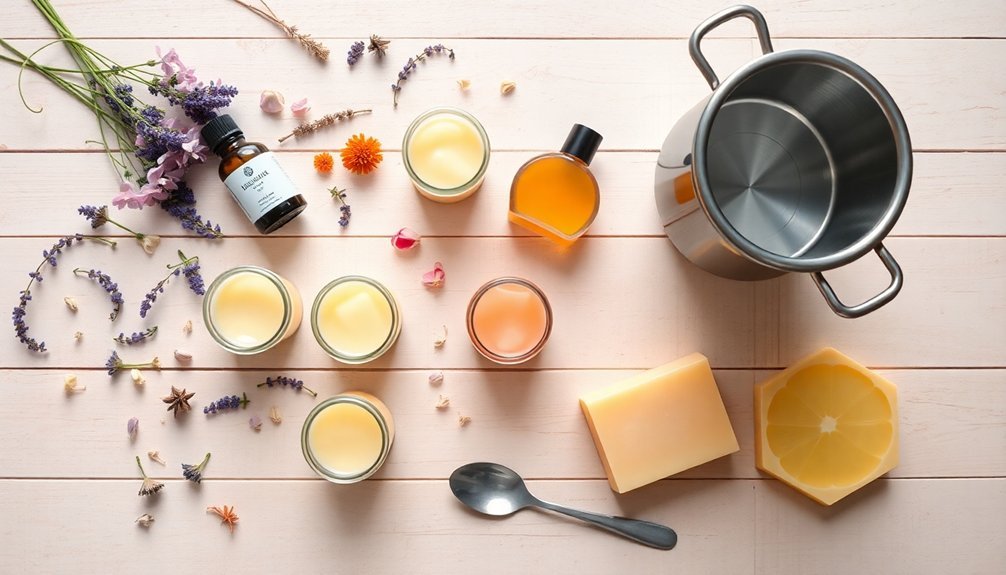
Once you understand the fundamentals of solid perfume making, you'll discover it's a rewarding craft that offers endless creative possibilities.
The basic formula combines beeswax and carrier oils like almond or jojoba in equal parts, creating a solid base for your fragrance blend. Using a double boiler setup ensures proper melting and mixing of ingredients.
Your scent composition follows the fragrance pyramid structure, incorporating top, middle, and base notes for a well-rounded perfume.
You'll need to carefully balance essential or fragrance oils to achieve your desired scent while avoiding skin irritation.
When crafting your blend, consider using grounding notes like sandalwood or vanilla to add depth and staying power.
The beauty of solid perfumes lies in their versatility – you can customize scents to match any preference, from floral to woody, making each creation uniquely yours.
Essential Tools and Raw Materials
To make solid perfumes at home, you'll need basic equipment like measuring tools, a double boiler, and small containers for storage.
Your choice of waxes and carrier oils forms the foundation of your perfume, with beeswax and jojoba oil being popular options for their stability and skin-friendly properties. Coconut oil can be used as an excellent carrier oil alternative for its smooth texture and natural properties.
Essential oils are the heart of your fragrance creation, so you'll want to select and blend them carefully based on their aromatic profiles and therapeutic benefits.
Basic Equipment Needed
Creating solid perfumes at home requires several essential tools and materials that you'll need to gather before starting.
You'll need either a microwave or double boiler to melt your waxes effectively. For storing your finished perfumes, get small containers like 2-ounce metal tins or black Slimline lip balm tubes.
Accurate measurements are vital, so invest in a reliable scale and glass measuring cups. The process requires essential oils and beeswax as core ingredients for making your signature scents.
Don't forget to pick up disposable pipettes for adding fragrance oils with precision. These simple tools will help you create consistent, high-quality solid perfumes every time.
While you might be tempted to skip some items, having the right equipment guarantees your perfume-making process goes smoothly and your final product turns out exactly as intended.
Waxes and Carrier Oils
With your equipment ready, let's focus on selecting the right waxes and carrier oils for your solid perfume. You'll need to choose between traditional beeswax, which offers excellent scent retention, or vegan alternatives like candelilla or soy wax. Each wax has unique properties that'll affect your final product's texture and fragrance longevity.
| Wax Type | Properties | Best Used With |
|---|---|---|
| Beeswax | Long-lasting, stable | Any carrier oil |
| Candelilla | Dense, vegan | Jojoba oil |
| Soy | Versatile, softer | Sweet almond oil |
| Floral | Naturally scented | Grapeseed oil |
| Blend | Customizable | Fractionated coconut oil |
For carrier oils, you'll want to take into account absorption rates and skin compatibility. Jojoba oil's neutral scent makes it ideal, while fractionated coconut oil works well for sensitive skin. Remember that proper wax-to-oil ratios are essential for achieving the perfect solid perfume consistency.
Essential Oil Selection
Three key components form the foundation of any solid perfume: top, middle, and base notes.
Begin by selecting your top notes like bergamot or wild orange for the initial scent impact. Then, choose middle notes such as rose or lavender to provide depth once the top notes fade. Finally, add base notes like cedarwood or vanilla for lasting power.
To guarantee your blend's success, you'll need to take into account each oil's compatibility and concentration. Remember that essential oils are potent, so start with just a few drops.
Don't forget to include a fixative oil like frankincense or patchouli to stabilize your creation. Before mixing your final blend, perform a patch test to check for sensitivities, and always use precise measuring tools for accurate proportions.
Selecting the Right Waxes and Carrier Oils
The foundation of any solid perfume lies in selecting the right combination of waxes and carrier oils. For your base, you'll need a quality wax – beeswax is traditional, while candelilla offers a vegan alternative.
Consider their melting points and hardness when making your choice.
For carrier oils, you've got several excellent options. Jojoba and almond oils are popular choices due to their neutral scents and skin-friendly properties. Fractionated coconut oil works well too, especially if you're looking for something light and quick-absorbing.
Start with a 1:1 ratio of wax to carrier oil. You can adjust this ratio to achieve your desired consistency – more wax creates a firmer product, while extra oil results in a softer, more spreadable perfume.
Choosing and Blending Essential Oils
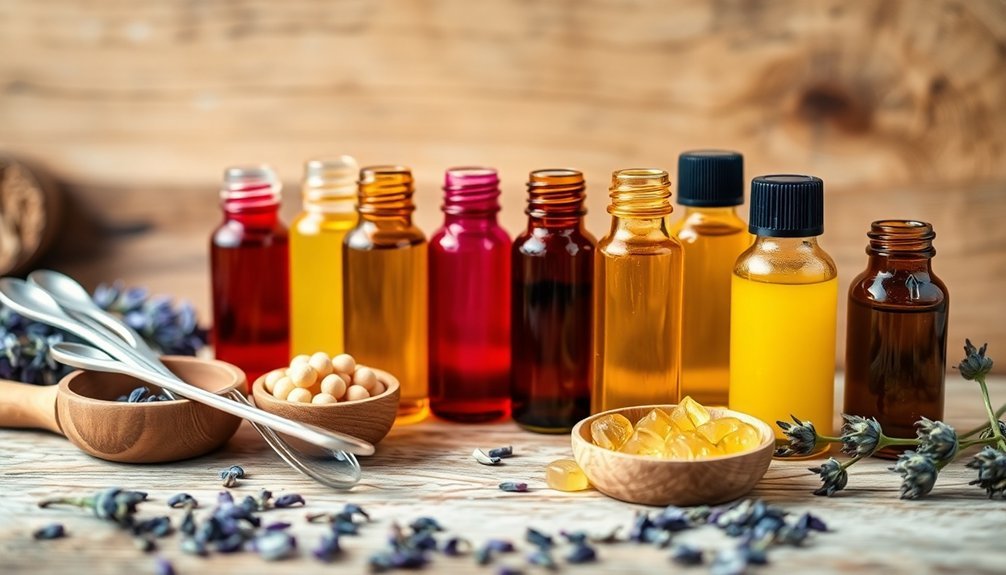
Building your perfect solid perfume starts with mastering the art of oil blending. You'll want to create a balanced composition using top, middle, and base notes. Start with citrus oils like lemon or bergamot for fresh top notes, then add floral middle notes such as ylang ylang or rose for depth. Finally, incorporate earthy base notes like cedarwood or sandalwood for lasting power.
| Mood | Essential Oils | Benefits |
|---|---|---|
| Energizing | Grapefruit + Peppermint | Uplifts spirits |
| Romantic | Rose + Vanilla | Creates intimacy |
| Calming | Lavender + Frankincense | Reduces stress |
Remember to use oils sparingly – they're highly concentrated. Start with a 2:1:1 ratio of top, middle, and base notes, then adjust to your preference. Don't forget to add a fixative like benzoin to help your scent last longer.
Step-by-Step Perfume Making Process
Creating your own solid perfume requires just five essential steps and basic equipment you likely have at home.
Start by setting up your double boiler or a heat-safe bowl over simmering water. Combine your chosen wax with your carrier oil, such as jojoba or almond oil, and heat until they're completely melted.
Once melted, remove the mixture from heat and quickly stir in your essential oils while it's still liquid but not too hot.
Pour the blend immediately into your prepared containers, whether they're small metal tins or lip balm tubes.
Let your perfume cool undisturbed until it's fully solidified, which typically takes about an hour.
Don't rush the cooling process, as this guarantees proper texture and scent distribution in your finished solid perfume.
Creating Signature Scent Combinations

While many beginners start with single-note fragrances, crafting signature scent combinations lets you develop truly unique solid perfumes that reflect your personality. You'll want to experiment with different fragrance families and follow basic layering principles to create balanced blends.
| Base Note | Middle Note | Top Note |
|---|---|---|
| Sandalwood | Rose | Bergamot |
| Vanilla | Jasmine | Lemon |
| Patchouli | Strawberry | Grapefruit |
Start by selecting oils from each category, following a 30/50/20 ratio of top/middle/base notes. Test small amounts on your skin, as body chemistry affects how scents interact. Keep detailed notes of successful combinations, including exact measurements and ratios. You'll find some classic pairings like floral-citrus or woody-spicy provide reliable starting points for your experiments.
Packaging and Storage Solutions
When you're ready to package your solid perfume, you'll want to select containers that match both your style preferences and practical needs, whether it's sleek glass jars for home display or portable lockets for on-the-go use.
Your choice of packaging will impact how well your perfume holds up over time, so opt for air-tight containers that can protect against moisture, heat, and sunlight.
You'll need to store your perfumes in cool, dark places and guarantee the containers are thoroughly cleaned before use to maintain the integrity of your fragrance.
Choosing Perfect Containers
The perfect container serves as your solid perfume's protective sanctuary, keeping your handcrafted creation fresh and ready for use. When selecting your container, consider both functionality and aesthetics. Choose durable materials like aluminum, glass, or tins that can withstand temperature changes and daily handling.
| Container Type | Best Uses | Features |
|---|---|---|
| Small Tins | Travel | Compact, lightweight |
| Glass Jars | Home Display | Elegant, recyclable |
| Vintage Lockets | Special Occasions | Unique, decorative |
You'll want to personalize your container to match your perfume's character. Add custom labels to track different scents, or enhance the presentation with painted designs and ribbons. For gifting, consider themed packaging that complements the fragrance – like floral decorations for garden-inspired scents.
Proper Storage Methods
Proper storage methods can make or break your solid perfume's longevity and performance. Store your creation in a cool, dark place away from direct sunlight and heat sources to prevent melting and preserve the fragrance.
You'll want to keep it in an airtight container to protect against moisture and humidity.
When traveling, opt for leak-proof travel tins that comply with TSA regulations. Pad your containers with soft materials to prevent damage, and always secure them properly in your bag.
For long-term storage, use dark-colored containers with tight-fitting lids, and don't forget to label them with dates. Keep your perfumes away from strong-smelling items, cleaning supplies, and electrical vents.
If you're storing multiple perfumes, maintain consistent conditions for all of them to guarantee peak preservation.
Tips for Perfect Consistency and Long-lasting Fragrance
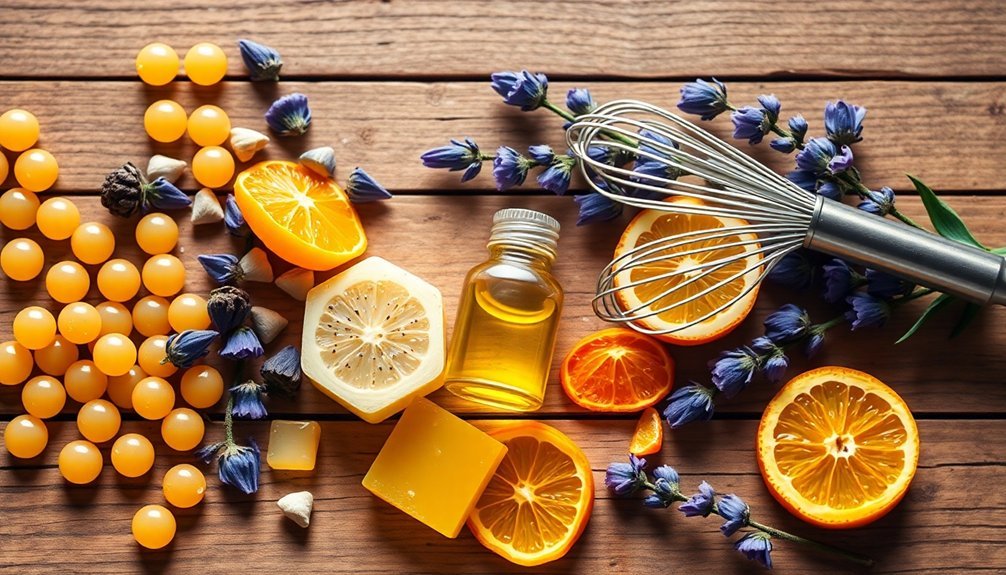
Creating solid perfumes that maintain their shape and scent requires careful attention to both consistency and fragrance composition. Start by maintaining a precise ratio of beeswax to oils, keeping wax content below 30% of your total mixture.
Melt ingredients in a double boiler and let them cool slowly to prevent air bubbles.
For lasting fragrance, aim for a 9% fragrance load and consider using synthetic fragrance oils instead of essential oils if longevity is your priority.
Build your scent in layers with top, middle, and base notes, and add fixatives like orris root oil to stabilize the fragrance.
You can adjust the texture by varying the wax-to-oil ratio – more wax creates a firmer product, while more oil yields a softer consistency.
Popular Solid Perfume Recipes to Try
Whether you're a beginner or experienced perfumer, these tried-and-tested solid perfume recipes offer something for every scent preference.
Craft your perfect signature scent from our collection of solid perfume recipes, designed for both novice and expert perfumers.
For a classic floral option, try the Vanilla Lavender blend with its comforting combination of 10 drops each of vanilla and lavender oils.
If you prefer earthy scents, the Patchouli Blend combines 30 drops of patchouli with 20 drops of orange for a grounding experience.
For an energizing morning fragrance, mix the Citrus Sunrise's sweet orange, lemon, and lime oils.
The Flannel & Whiskey recipe creates a sophisticated masculine scent using cedarwood, bergamot, and sandalwood.
Those seeking a balanced floral-citrus blend will love the Ylang Ylang Base, which combines 10 drops ylang ylang with citrus and lavender notes for a well-rounded aroma.
Frequently Asked Questions
Can I Use Dried Flowers or Herbs in My Solid Perfume?
You shouldn't add dried flowers directly to solid perfumes as they won't release scents effectively. Instead, use essential oils or create infused oils from these botanicals for better fragrance results in your perfume.
How Long Does Homemade Solid Perfume Typically Last Before Expiring?
Your homemade solid perfume can last 6-12 months when stored properly in a cool, dry place. You'll notice it's time to replace it if the scent changes or the texture becomes grainy.
What Should I Do if My Solid Perfume Becomes Too Soft?
If your solid perfume's too soft, store it in a cool place and refrigerate it briefly. You can also remelt it and add more wax to achieve a firmer consistency. Keep it away from heat.
Can I Melt and Remix My Solid Perfume if I Don't Like It?
Yes, you can melt and remix your solid perfume if you're unhappy with it. Use a double boiler or microwave in short bursts, then add new essential oils to adjust the scent while it's melted.
Why Does My Solid Perfume Smell Different on My Skin Than in Container?
Your skin's pH and body chemistry interact with the fragrance, changing how it smells. Plus, your body heat warms the perfume, releasing different scent notes that you can't detect in the container.
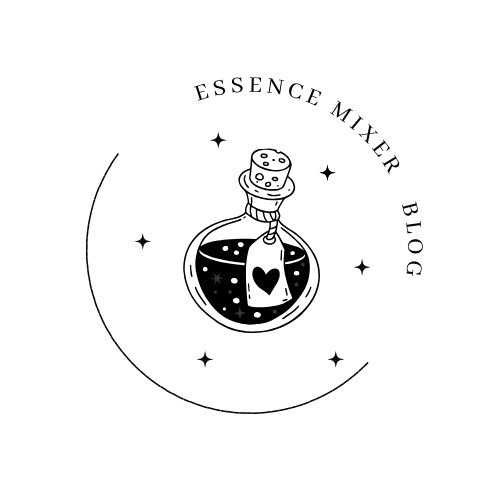
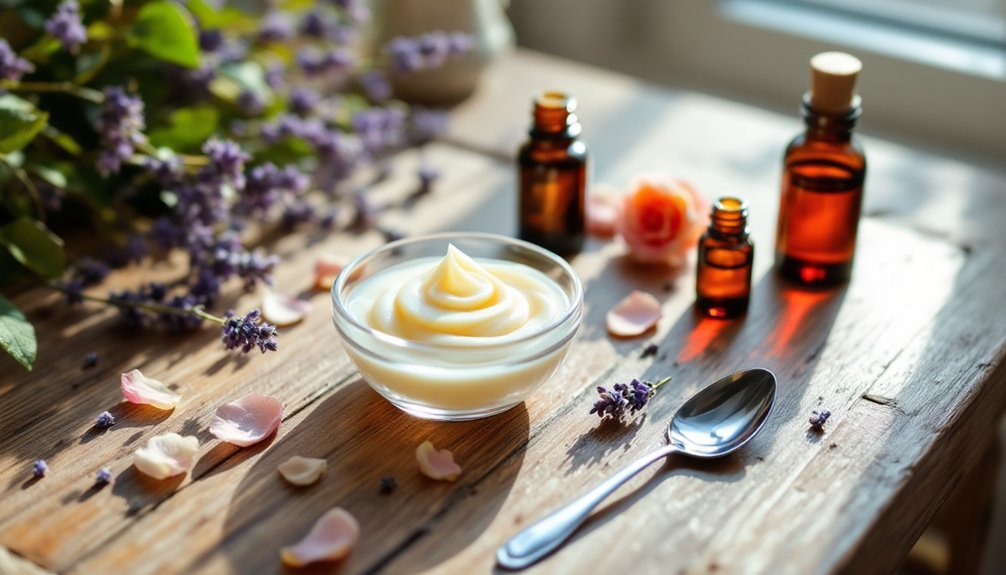



Leave a Reply